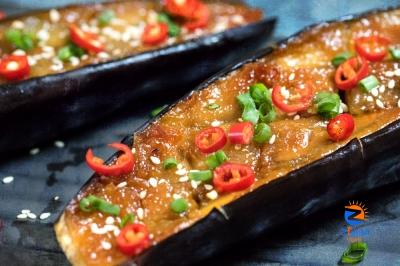
[ad_1]

KUALA LUMPUR, April 6 — Known as nasu dengaku in Japanese, the miso glazed eggplant is one of those dishes where you might have never eaten before but once you have, you wonder where it’s been all your life.
It’s a dish that makes complete sense… at least to my often jaded palate.
Perhaps it’s the pleasurable dance of tastes and textures.
The salty-sweetness of the miso is rounded out by the gentle, tempering nature of mirin. (Fermented soybean paste, meet fermented rice wine. Be good friends.)
Advertisement
Even the eggplant has two faces: the tender morsels of its creamy flesh, scored into ready cubes; the crisp, caramelised surface, kissed by fermented manna.
To achieve this twinning of textures, the eggplant is first grilled, pan fried or roasted (I chose the third option; less of a mess) before a final turn with the broiler mode of the oven to allow the miso glaze to achieve its full glory.
A traditional serving of nasu dengaku is presented with a scattering of white sesame seeds and sliced spring onion, but this is where I have fun by incorporating a surprising Malaysian twist: red cili padi (bird’s eye chillies)!
Advertisement
Beyond the bold burst of colour, the red chillies add a welcome pop of heat. If you thought this miso glazed eggplant was a winner before, now it’s absolutely a champion of a dish!

Look for an eggplant that is shiny, smooth and free from blemishes.
MISO GLAZED EGGPLANT WITH CILI PADI
There are many smaller elements at play here, from the aromatics (sesame oil and sesame seeds) to the pops of colour (green onion and red chillies). But the essential ingredients for this recipe really boils down to the eggplant and the miso.
In choosing your eggplant, look for a specimen that is firm to the touch; neither too hard or soft. Basically you’re avoiding one that is unripe or too mushy.

Score the eggplant in a crisscross pattern.
Another way to judge whether an eggplant is perfect for cooking is by its appearance: the skin ought to be shiny, smooth and free from blemishes; the stem a fresh green.
After scoring the eggplant in a crisscross pattern, you might want to soak it briefly in a bowl of water; this, supposedly, will remove any astringency. A drop of lemon juice or vinegar here will help prevent the oxidation of the exposed flesh of the eggplant.
For the miso paste, often chefs in Japanese restaurants and izakayas would go for the darker hued red miso. Any type of miso works fine, I find. Personally I prefer the more delicate white miso.
Just as French chefs might recommend you use a wine you would drink when cooking, I enjoy making miso soup with organic white miso paste far more than the stronger flavoured red miso. As always, you do you.

The more delicate white miso is used for the glaze.
One final note: you could use green bird’s eye chillies here — they will taste as fiery as the red variety — but you’d lose the explosive contrast of colours. The red cili padi, green spring onion and white sesame seeds.
My advice: hunt down the red ones and sprinkle some “magic” — red, green and white — to complete the dish.
Ingredients
- 1 large Japanese eggplant
- Sesame oil
- 2 tablespoons white miso paste
- 1 tablespoon granulated sugar
- 1 tablespoon mirin
- 1 teaspoon toasted white sesame seeds
- 1 stalk spring onion, sliced finely
- 2 red bird’s eye chillies (cili padi), sliced finel
Method
Prepare a bowl of water. Add a few drops of lemon juice or vinegar. Preheat the oven to 200°C.
Slice the eggplant into half lengthwise. Score each half of the eggplant in a crisscross pattern on the cut side. Lightly brush the scored surface with sesame oil, just enough to coat.

Garnishes: green spring onion, red ‘cili padi’ and white sesame seeds.
Place both halves of the scored eggplant on a tray lined with baking paper, cut side facing down. Roast at 200°C for 15-20 minutes.
While the eggplant is roasting, mix the white miso, sugar and mirin in a small bowl until well combined. Set aside.
Once the eggplant is fully cooked (the flesh fork-tender and the skin slightly wrinkly), remove the tray from the oven.
Flip the eggplant halves so the cut side is facing up. Brush the scored surface with the miso glaze and return to the oven, using the broiler function to caramelise the glazed top of the eggplant.

Sprinkle some ‘magic’ to complete the dish.
Allow to broil for about 5 minutes. Once the glaze starts bubbling but before it blackens, remove the tray from the oven.
Sprinkle with white sesame seeds, sliced spring onions and red cili padi. Serve immediately.
*Follow us on Instagram @eatdrinkmm for more food gems.
[ad_2]